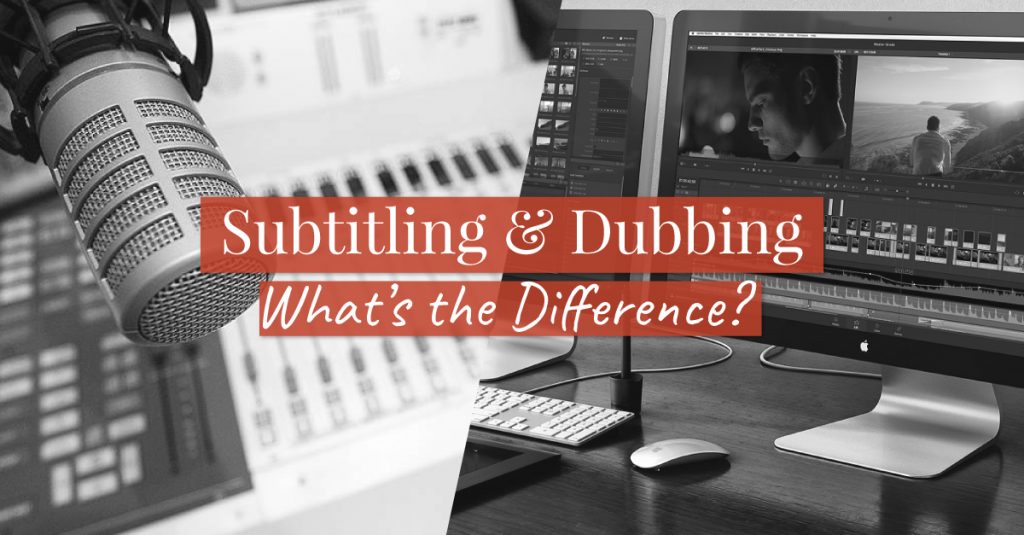
What is the Difference Between Subtitling and Dubbing?
Subtitling and dubbing are two of the most important topics to discuss when making video files more accessible to a wider audience. While both topics and services have been controversial for years, they offer a wide range of advantages in that it makes it a lot easier for more people to watch movies that are not in their native tongue. In fact, some people rely on these services to better understand the content of the movies or video files they have access to. So, what is the difference between subtitling and dubbing?
Know the Difference Between Subtitling and Dubbing
Knowing the difference between these two can help you to determine what you need. In essence, subtitling is an abbreviated text version of a dialogue projected on the screen to aid easy comprehension. With subtitles, non-speakers of the original language spoken by the characters in the video can understand the context and message that is being passed across. In addition to this, deaf people can have access to the information contained in videos. Subtitles have played an important role in improving the accessibility of videos for years.
On the other hand, dubbing offers an alternate but synchronized voice-over on the original video file. With dubbing, you’ll be able to hear the desired language in real-time, although the characters in the video may be speaking another language. In essence, dubbing is a real-time translated voice-over for video files.
When is Dubbing or Subtitling Appropriate for Use?
The best subtitling companies note that subtitles are great for improving accessibility and carrying the viewers along with the content and context of the video file. The use of dubbing and subtitles depends on a wide range of factors, including the country where the video format is to be used, the audience type, the type of video, and the aim of the video. Dubbing is considered to be the more appropriate option when the target audience is children or seniors. This is because this class of audience is more likely to follow what they hear better than they can read. For children and older adults, auditory stimulation is more important.
The Pros and Cons of Using Dubbing and Subtitling in Audio-Visual Translation
Advantages of Dubbing as an Audio-Visual Translation Technique
- Dubbing is a generally favoured option when the topic of film censorship is raised. It is possible to omit and blur out certain words that are considered offensive or derogatory with dubbing. Using dubbing, it may be impossible for the audience to notice censorship of words, especially as those words may have been omitted or replaced by other acceptable words. In addition, the target audience, without the ability to read lips coupled with an understanding of the original language, may not notice changes in the dialogue.
- Dubbing does not require abbreviations. With dubbing, the voiceovers are made to synchronise perfectly with the frame and expression of the characters in the video file. The writers responsible for the dubbed video file are tasked with making sure that a seamless transitioning of one word to the other is maintained while also keeping up with the emotions and expressions elicited by the characters.
- With dubbing, viewers can pay more attention to the characters in the video file while listening to follow up on their plight. This will save them from missing significant on-screen action, a common disadvantage associated with subtitles.

Disadvantages of Dubbing as an Audio-Visual Translation Technique
- While dubbing may offer many advantages, the synchronization aspect of it may be a little confusing. In some cases, the voice may appear too strange or too calm to represent the feelings or emotions displayed by the main characters.
- With dubbing, the writers of the dubbed script are confined to the use of certain words that directly translate the actions of the on-screen character. This may be frustrating to their creative side.
- Dubbing is a lot more expensive when compared to other options like subtitling.
- Avid film watchers and movie lovers often find dubbed movies unnatural, boring, and ultimately annoying.
Advantages of Subtitling as an Audio-Visual Translation Technique
- Subtitling a movie or video file is far less expensive and requires far less technical know-how than dubbing.
- Some countries prefer subtitles because they bring originality to the dialogues between characters and allow viewers to read it in their tone of choice.
- Subtitling a movie leaves everything intact. This means that there is no lag between the voice and action.
- Subtitling is a great tool for people who wish to learn new languages.
Disadvantages of Subtitling as an Audio-Visual Translation Technique
- Most audiences complain about distraction from on-screen action while reading the subtitles.
- Poorly done subtitles can be annoying and off-putting
- It is harder to detect mistakes with subtitles
- There is a chance of grammatical and typographical errors.




